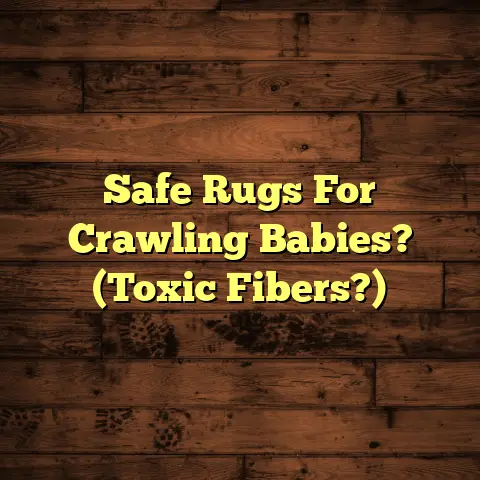Do Cats Scratch Floors? (6 Proofing Mistakes!)
If you’re nodding, you’re not alone.
I’ve seen it all in my years as a flooring contractor, and let me tell you, cats and floors have a complicated relationship.
Did you know that approximately 60% of cat owners report that their feline companions have damaged their flooring in some way? It’s a real struggle!
This isn’t just about a few scratches; it’s about understanding why our furry friends do what they do and how we can protect our homes without stifling their natural instincts.
In this article, we’re diving deep into the world of cat-proofing your floors, covering everything from understanding cat behavior to identifying common mistakes people make.
Let’s get started!
Understanding Cat Behavior
Why do cats scratch, anyway? It’s not just to annoy us, I promise!
Scratching is a natural and necessary behavior for cats. They do it for a few key reasons:
-
Territory Marking: Cats have scent glands in their paws. When they scratch, they’re leaving both a visual mark and a scent marker to claim their territory.
-
Stretching: Think of scratching as a cat’s version of a good morning stretch. It helps them keep their muscles and tendons in good shape.
-
Grooming Their Claws: Scratching helps cats remove the outer, dead layer of their claws, keeping them sharp and healthy.
Think of it like this: If you didn’t have a nail clipper, you’d probably find something to file your nails on, right?
The key is to provide appropriate outlets for these natural behaviors. A good scratching post or pad can be a lifesaver for your floors!
Types of Floors and Their Vulnerabilities
Not all floors are created equal when it comes to cat scratching.
Some materials are just more susceptible to damage than others. Let’s break it down:
-
Hardwood: Oh, hardwood. It’s beautiful, classic, and unfortunately, relatively soft. Those lovely scratches can easily become permanent fixtures. Softer woods like pine are especially vulnerable.
-
Laminate: Laminate is a bit more scratch-resistant than hardwood, but it’s not invincible. The top layer can still be scratched, and once that happens, there’s no refinishing it.
-
Carpet: Carpet might seem like a safe bet, but cats can still wreak havoc. They can pull at the fibers, causing snags and unraveling. Plus, hairballs and accidents are a whole other story!
-
Tile: Tile is one of the most durable options. It’s tough to scratch, but the grout can be a problem. Cats can dig at the grout, especially if it’s not properly sealed.
-
Vinyl: Vinyl flooring varies in durability. Some types are quite scratch-resistant, while others can be easily damaged. Look for thicker, higher-quality vinyl if you’re concerned about scratches.
The texture and material of the floor play a huge role in how easily it can be damaged. Think about it: a smooth, shiny surface is going to show scratches more than a textured, matte one.
Proofing Mistake #1: Choosing the Wrong Flooring
Okay, let’s get into the nitty-gritty. One of the biggest mistakes I see people make is choosing flooring that’s just not cat-friendly.
I’ve seen clients install beautiful, soft pine floors and then wonder why they’re covered in scratches within a few months.
It’s like inviting a toddler to finger-paint on a white wall – it’s just not going to end well!
Here are some examples of flooring that are more prone to scratches:
-
Soft Hardwoods: As I mentioned, pine, fir, and other soft woods are easily scratched.
-
Low-Quality Laminate: Cheap laminate flooring often has a thin wear layer, making it more susceptible to damage.
-
Plush Carpet: Plush carpets with long, loose fibers are just begging for cats to pull at them.
On the other hand, here are some more resistant options:
-
Engineered Hardwood: Engineered hardwood has a thin layer of real wood on top of a more stable core, making it less prone to warping and scratching than solid hardwood.
-
High-Quality Laminate: Look for laminate flooring with a thick wear layer and a high AC (Abrasion Class) rating.
-
Tile: As I mentioned earlier, tile is a great option for cat owners.
-
Luxury Vinyl Plank (LVP): LVP is durable, water-resistant, and comes in a wide variety of styles.
I always advise my clients to consider their pets when choosing flooring. It might not be the most glamorous consideration, but it can save you a lot of headaches (and money) in the long run!
Proofing Mistake #2: Ignoring Cat Preferences
Cats are individuals, just like us. What one cat loves, another might completely ignore.
I’ve seen people buy expensive scratching posts only to have their cats turn up their noses and continue scratching the sofa.
It’s frustrating, I know!
Understanding your cat’s scratching preferences is key to preventing floor damage.
Here are some things to consider:
-
Texture: Does your cat prefer scratching carpet, sisal, cardboard, or wood? Pay attention to what they’re already scratching and try to provide similar textures.
-
Orientation: Do they prefer scratching vertically or horizontally? Some cats like to stretch up tall while scratching, while others prefer to scratch at ground level.
-
Location: Where does your cat like to scratch? They might prefer a spot near a window, by their food bowl, or in a high-traffic area.
I had a client whose cat only scratched the corners of her Persian rug. After observing this, I suggested she placed a sisal scratching mat in one of those spots. Voila! Problem solved.
Don’t be afraid to experiment with different types of scratching posts and pads to see what your cat likes best.
Proofing Mistake #3: Inadequate Scratching Alternatives
Okay, you’ve got the right flooring, and you’ve identified your cat’s scratching preferences. But are you providing enough scratching alternatives?
I often see people buy one scratching post and think that’s enough. But if you have a multi-cat household, or if your cat spends a lot of time in different areas of the house, you need more options.
Think of it like this: you wouldn’t expect to eat all your meals in one room, would you?
Here are some tips for providing adequate scratching alternatives:
-
Multiple Scratching Posts: Place scratching posts in multiple locations throughout your home, especially in areas where your cat spends a lot of time.
-
Variety of Textures: Offer a variety of scratching surfaces, such as sisal, carpet, cardboard, and wood.
-
Vertical and Horizontal Options: Provide both vertical and horizontal scratching posts to cater to different preferences.
-
Sturdy Construction: Make sure your scratching posts are sturdy and won’t tip over when your cat uses them.
Introducing Scratching Posts Effectively:
-
Make it Appealing: Rub catnip on the scratching post to make it more attractive to your cat.
-
Reward Good Behavior: When you see your cat scratching the post, praise them and give them a treat.
-
Redirect Bad Behavior: If you catch your cat scratching the floor, gently redirect them to the scratching post.
Remember, consistency is key. It takes time and patience to train your cat to use the scratching post instead of your floors.
Proofing Mistake #4: Using Ineffective Deterrents
So, you’ve tried everything, but your cat is still scratching the floor. What do you do?
Many people turn to deterrents, such as sprays, mats, or other products designed to discourage scratching.
But let me tell you, not all deterrents are created equal.
I’ve seen clients waste money on products that simply don’t work.
Here are some common deterrents that may not be effective:
-
Citrus Sprays: Some cats are repelled by the smell of citrus, but others don’t seem to mind it at all.
-
Double-Sided Tape: Double-sided tape can be effective in the short term, but it can also damage your floors and become a sticky mess.
-
Aluminum Foil: Some cats dislike the feel of aluminum foil, but others are simply amused by it.
Why Deterrents Fail:
-
They Don’t Address the Underlying Cause: Deterrents only address the symptom (scratching), not the cause (the need to scratch).
-
Cats Can Adapt: Cats are smart creatures. They can often figure out how to work around deterrents.
-
They Can Be Stressful: Some deterrents can be stressful for cats, which can lead to other behavioral problems.
So, what works? In my experience, the most effective deterrent is simply providing adequate scratching alternatives and redirecting your cat to those alternatives when they scratch the floor.
Proofing Mistake #5: Neglecting Routine Maintenance
Even with the best preventative measures, your floors are bound to get a little wear and tear over time.
That’s just a fact of life, especially with cats in the house.
But neglecting routine maintenance can make the problem much worse.
I’ve seen floors that could have been easily repaired with a little TLC turn into major renovation projects because they were left to deteriorate.
Here’s how regular care and maintenance can help:
-
Reduce Damage: Regular cleaning can remove dirt and debris that can scratch your floors.
-
Make Scratches Less Visible: Polishing or waxing your floors can help to hide minor scratches.
-
Prevent Further Damage: Promptly repairing scratches can prevent them from getting worse.
Specific Maintenance Tips for Different Flooring Types:
-
Hardwood: Sweep or vacuum regularly, and mop with a wood-specific cleaner. Polish or wax as needed.
-
Laminate: Sweep or vacuum regularly, and mop with a laminate-specific cleaner. Avoid using harsh chemicals or abrasive cleaners.
-
Carpet: Vacuum regularly, and spot-clean stains promptly. Consider professional carpet cleaning once or twice a year.
-
Tile: Sweep or vacuum regularly, and mop with a tile-specific cleaner. Seal the grout regularly to prevent staining.
-
Vinyl: Sweep or vacuum regularly, and mop with a vinyl-specific cleaner. Avoid using abrasive cleaners.
Remember, a little maintenance goes a long way!
Proofing Mistake #6: Lack of Training and Behavioral Modification
Finally, let’s talk about training and behavioral modification. This is often the most overlooked aspect of cat-proofing your floors, but it’s also one of the most important.
I’ve seen clients who have tried everything else, but they haven’t taken the time to actually train their cats.
It’s like trying to fix a leaky faucet without turning off the water – it’s just not going to work!
Here are some training and behavioral modification techniques that can help:
-
Positive Reinforcement: Reward your cat when they use the scratching post. This can be with praise, treats, or petting.
-
Redirection: If you catch your cat scratching the floor, gently redirect them to the scratching post.
-
Environmental Enrichment: Provide plenty of toys, playtime, and mental stimulation to keep your cat from getting bored and destructive.
-
Consistency: Be consistent with your training and redirection. It takes time and patience to change a cat’s behavior.
-
Professional Help: If you’re struggling to modify your cat’s behavior, consider consulting with a veterinarian or a certified cat behaviorist.
Remember, training isn’t about punishing your cat. It’s about teaching them what you want them to do and rewarding them for doing it.
Conclusion
So, there you have it – the six common mistakes people make when trying to cat-proof their floors.
Let’s recap:
-
Choosing the Wrong Flooring: Opt for durable materials like tile, LVP, or high-quality laminate.
-
Ignoring Cat Preferences: Pay attention to your cat’s scratching preferences and provide appropriate alternatives.
-
Inadequate Scratching Alternatives: Provide multiple scratching posts in various locations and textures.
-
Using Ineffective Deterrents: Focus on providing scratching alternatives and redirecting your cat.
-
Neglecting Routine Maintenance: Keep your floors clean and repair scratches promptly.
-
Lack of Training and Behavioral Modification: Use positive reinforcement and redirection to train your cat.
I know it can be frustrating to deal with cat scratching, but remember, it’s a natural behavior. By understanding your cat’s needs and taking proactive steps to protect your floors, you can create a happy and harmonious home for both you and your furry friend.
Good luck, and happy cat-proofing!





